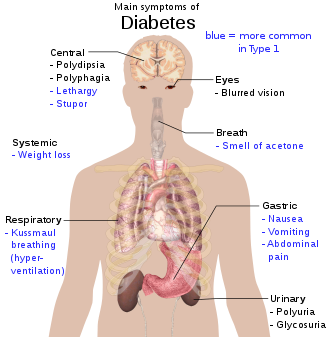Diabetes Types And Symptoms
Health Tips By Taslima Akter Eva
Student of Chittagong University Pharmacy
Department 4th year. And-Nishat Tasnim Oishee
Graduate CVASU Food Science & Technology
This article is all about directions diabetes typts and symptoms
will help to prepare for diabetes patients
Diabetes Mellitus(DM) generally known as diabetes, is a metabolic disease thatWhat is Diabetes Mellitus:
occurs when the pancreas can not produce enough insulin
which is important to maintain the glucose level at a normal range. Deficiency of insulin increases the amount of glucose in the blood and excess glucose is excreted in the urine.Blood glucose range in a healthy person and a diabetes patient: In a healthy person, the amount of glucose in the blood plasma (blood juice) is less than 6.4 mmol/L when fasting and less than 7.5 mmol/L two hours after eating.Diabetes can be diagnosed when the amount of glucose in the blood plasma (plasma) is more than 7.5 mmol/L or more or when the amount of glucose in the blood plasma (blood juice) is 11 mmol/L or more two hours after eating 75 grams of glucose. Types of Diabetes: 1. Insulin Dependent Diabetes Mellitus(IDDM) or Type 1 Diabetes: Insulin is not produced in the body of such patients at all. This type of diabetes is also called juvenile-onset diabetes because it is usually seen in people under 30 years of age(average age is 10-20 years). All these patients have to take insulin injections to survive. Otherwise, the blood sugar rises very fast and in a short time, he becomes unconscious due to acid poisoning in the blood and dies. Acetone is found in the urine when unconscious. 2. Non-Insulin Dependent Diabetes Mellitus (NIDDM) or Type 2 diabetes: About 80% patient of diabetes suffer from this type. In most cases the age of this class of patients is above 30 years.Their body produces insulin but it is not enough. This type of patients become obese in most cases as the effectiveness of insulin decreases. If the patients are not given insulin, they will not be poisoned like type 1 patients. 3. Gestational Diabetes: Gestational diabetes is often caught during pregnancy and does not exist immediately after delivery. Diabetes during pregnancy can be dangerous for pregnant women and newborns. It's important to control gestational diabetes to protect the baby's growth and development. Diagnosis Of Diabetes (Three P's of diabetes): The most common symptoms to diagnose this condition are called three P's of diabetes.These are- 1. Polydipsia (increased thirst) 2. Polyuria (frequent urination) 3. Polyphagia (increased appetite) If someone is experiencing an abnormal elevation of thirst, urination,
or appetite that lasts over a period of several days then they should see
a doctor and specially when someone is particularly experiencing more than
one of the three P’s.But each of the three P’s can occur individually as
a symptom of conditions other than diabetes so you shouldn’t panic before consultation with a doctor.
Consult a doctor If you’re experiencing symptoms that are new and
persistent then you should always make an appointment with your doctor . Other general symptoms are: - Weight loss despite eating enough Presence of ketones in the urine (ketoacidosis) Increased thirst Frequent urination Extreme hunger Frequent infections ( gums , skin infections and vaginal infections) Fatigue Irritability Blurred vision Slow wound healing Who can get Diabetes:- Anyone can develop diabetes at anytime at any age. However, four types of people are more likely to have diabetes: 1. In whose family, such as parents, blood relatives have diabetes. 2. Those who are overweight 3. Those who do not do any work or physical exertion 4. Those who have been using cortisol for a long time. Is Diabetes an infectious disease?:- Diabetes is not a contagious or infectious disease. It is not transferrable from person-to-person through sexual contact, saliva, or blood. When the pancreas of our body does not produce enough of the hormone insulin, or the body can't use insulin properly due to specific reason ,that time diabetes occurs. Insulin helps carry sugar from the bloodstream into the cells and after that it converted into energy for immediate use or stored for the future.
Good food for diabetic patient :
1.Green leafy vegetables
* Spinach
* collard greens
* kale
*cabbage
* broccoli
2.Whole grains
-
* Brown rice * whole-grain bread * whole-grain pasta * Buckwheat * millet
* bulgur * rye 3.Fatty fish *salmon *mackerel *sardines *albacore tuna
*herring *trout -
4.Beans *kidney beans *pinto beans *black beans *navy beans *adzuki beans
5.Walnuts A study from 2018 suggested that walnuts are linked with a lower
incidence of diabetes. Walnuts also provide key nutrients, such as protein,
vitamin B-6, magnesium, and Iron.
6.Citrus fruits *Oranges *Grapefruits
*lemons
7.Berries *Blueberries *blackberries *strawberries *raspberries
8.Sweet potatoes
9. Probiotic yogurt
10.Chia seeds
11.Avocados
12.Eggs
13.Extra-Virgin Olive Oil
14.Garlic -
Food to avoid for diabetic patient :
1.High-GI fruits
The glycemic index (GI) represents how much a certain food can raise
Fruits that have high glycemic index and raise blood pressure are
*Watermelon
*Dried Dates
*pineapples
*overly ripe banana
2.Carb-heavy foods
*white bread
*puffed rice
*white rice
*white pasta
*white potatoes
*pumpkin
*popcorn
3.Saturated and trans fats
*Fries
* Chips
* baked goods
*grilled fish & meat
*steak
4.Refined sugar
*Sweets
*Cakes
*biscuits
5.Sugary drinks
*energy drinks
*some coffees,
*shakes
6.Salty foods
7.Alcohol -
given below -
blood sugar after a person has have eaten it.
Coming ………………………………………soon

